Figure 14.1. Generalized epilepsy subdivided into convulsive (motor) and nonconvulsive (nonmotor) seizures. (Adapted from Berg AT, Berkovic SF, Brodie MJ, et al. Revised terminology and concepts for organization of seizures and epilepsies: report of the ILAE Commission on Classification and Terminology, 2005–2009. Epilepsia. 2010;51(4):676–685.)
GMS may be observed in several different epilepsy syndromes and are associated with various etiologies, including a structural–metabolic (symptomatic), genetic (idiopathic), or unknown (cryptogenic) cause (5). While an inherited pattern is frequently assumed to reflect a genetic cause for GMS, family histories are often absent because complex genetic patterns and de novo mutations are common and are therefore not identified in pedigrees. A genetic component in patients with GMS does not preclude a progressive or structural–metabolic component (i.e., Lafora disease and laforin gene mutation EPM2A/B). Neither does a primary genetic pathogenesis exclude the possibility of a concomitant structural–metabolic cause (Fig. 14.2). Combinations of GMS semiologies and EEG may permit identification of a specific epilepsy syndrome that influences treatment and ultimately prognosis (early myoclonic encephalopathy). This chapter focuses on the electroclinical features of generalized tonic–clonic (GTC), tonic, clonic, and myoclonic seizures.

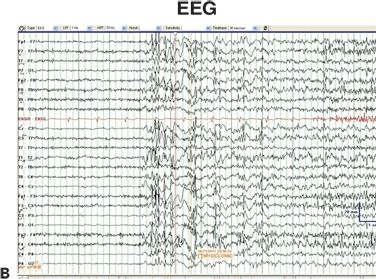
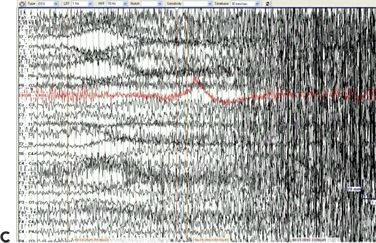
Figure 14.2. A 28-year-old Middle Eastern male was referred for epilepsy surgery. Recurrent GTC seizures were uncontrolled despite ASDs. A: MRI brain demonstrated a right temporal lobe lesion (arrow). B and C: Historical review suggested myoclonus beginning in adolescence. Video–EEG clearly demonstrated electroclinical myoclonic and GTC seizures confirming JME.
TYPES OF GMS
Generalized Tonic–Clonic
Descriptive terminology used by the ILAE defines a GTC seizure as one with a “tonic followed by a clonic phase” (6). Commonly known as a “grand mal,” major motor seizure, or convulsion, the GTC is the most feared of all seizure types by patients, families, and observers. There is a multiplicity of brain disorders that produce GTC seizures. GTC seizures are the most common GMS occurring in 20% to 25% of adults with epilepsy. GTC seizures are rare in neonates and in infants younger than 2 years of age due to the immaturity and lack of organization of the developing brain that is typified by variable neuronal excitability, imperfect myelination, and incomplete interhemispheric connections (7). GTC seizures may occur as a first or solitary seizure and as the sole or mixed manifestation of an epilepsy syndrome. Adult-onset genetic generalized epilepsy (GGE) with GTC seizures may occur in 13.4% to 34.8% of hospitalized patients; however, most appear within the first 2 decades of life (8). In elderly patients, the onset is usually focal and then evolves to a bilateral GTC seizure. Public perception that all patients with epilepsy manifest “grand mal” seizures perpetuates misconception and stigma for patients with epilepsy (3).
Semiology
A GTC seizure has an initial tonic phase followed by a clonic motor phase that is characterized by rhythmic jerking and may result from a generalized or a focal-onset seizure. When the propagation to both hemispheres is rapid and involves the motor cortex, the clinical semiology of a focal seizure evolving to a bilateral convulsion (“secondarily” generalized) may be difficult to separate from a (“primary”) GTC seizure that is associated with GGE. Myoclonic jerks may precede a GTC seizure during a myoclonic–tonic–clonic seizure to suggest a GGE such as juvenile myoclonic epilepsy (JME).
A prodrome is a nonictal warning composed of vague nonspecific symptoms that may occur prior to a GTC seizure. It can last from 5 minutes to a day before a seizure and often involve subtle changes in mood, cognition, and headache (9) though it may involve a variety of premonitory sensory, motor, autonomic, or psychic symptoms. As previously noted, motor signs in a GTC seizure involve an initial tonic phase and sudden loss of consciousness (5). Muscular rigidity occurs first with brief flexion followed by more prolonged tonic extension. The brief phase of flexion begins in the axial musculature and subsequently affects the limbs prior to more prolonged tonic extension lasting approximately 15 to 30 seconds. The tonic contraction is most intense in the axial musculature. When muscle contraction occurs in the thorax and abdomen, air is forced through the larynx to produce an “epileptic cry,” respiratory stridor, or moan (10). In this phase, an apparent opisthotonic posture with the arms extended and fingers either extended or clenched in a fist is seen (5). The wrists are flexed or extended, and the forearms are pronated, while the legs are extended at the hips, knees, and ankles (Fig. 14.3). During tonic muscular contraction, respiration is inhibited and cyanosis may be evident. The ensuing clonic phase lasts about 30 to 45 seconds and involves initially a centrally spreading tremulousness (5,10). Phasic reduction in muscle tone intermittently occurs to create the generalized clonic jerking (10). Audible respiratory grunting may be heard that wanes in a decrescendo fashion, and the seizure ceases after 1 to 2 minutes (10). The tongue may be bitten, and urinary incontinence may be evident. Most tongue bites associated with GTC seizures have a predisposition for the posterolateral tongue or cheek region (5,10). Hypersalivation also occurs and, with the vascularity of the tongue, may produce copious amounts of blood-tinged sputum (5). Autonomic features include pupillary dilation, tachycardia, and blood pressure elevation (10). Diaphoresis is present during and after the episode. Following the seizure, hypoventilation is encountered, which may be in the form of stridor with respiratory compromise or aspiration if the airway is not protected. There is marked individual variability between GTC seizures and between seizures in the same individual (5,10). Additionally, focal and lateralizing signs commonly occur in GTC seizures of patients with GGE and do not necessarily imply a focal onset (11).
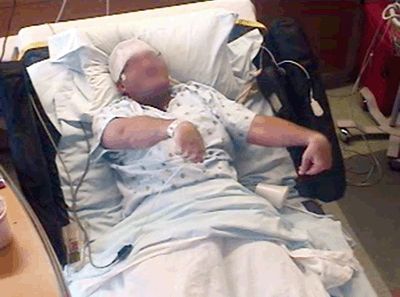
Figure 14.3. Generalized tonic extensor posturing preceding the clonic phase in a 32-year-old patient experiencing recurrent GTC seizures. Note the forearm pronation, wrist flexion, and partial finger extension.
The postictal state is initially composed of a flaccid unresponsive state of variable duration usually with recovery in 10 to 30 minutes. Confusion, disorientation, somnolence, headache, personality and mood changes, and myalgias may resolve over the next 24 hours. During this time, there is a notable loss of postural tone, unconscious state, and loss of deep tendon reflexes on examination. Ictal hypoventilation and subsequent postictal apnea may contribute to the development of cardiac arrhythmias (Fig. 14.4) (12). During the immediate postictal phase, there is nonspecific relaxation of the urinary sphincter resulting in urinary incontinence. Postictal agitation, confusion, and disorientation are common and characteristic. A postictal migraine-like headache, nausea, and vomiting may occur. Following a seizure, the postictal serum prolactin and creatine kinase may rise, though they have limited sensitivity and specificity as a biomarker for a GTC seizure (13).
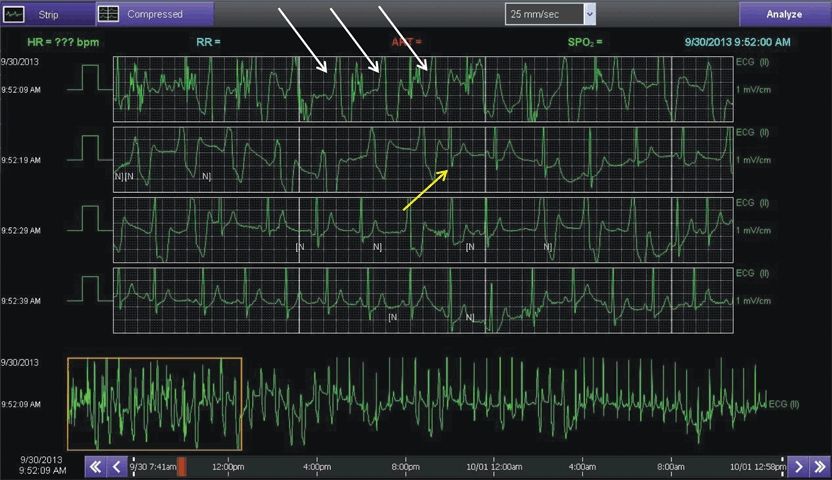
Figure 14.4. Cardiac telemetry after GTC seizure. Note the initial premature ventricular beats (white arrows) prior to reestablishing a normal sinus rhythm (yellow arrow).
Electrophysiology
The waking interictal EEG background of patients with GTC seizures associated with GGE is typically normal. Focal features may occur when comorbid conditions are present. Preceding interictal epileptiform discharges (IEDs) in the preseizure period may be seen prior to onset of clinical symptoms (14). Bursts of intermittent rhythmic theta and delta activity is more commonly observed in patients and family members in GGE (15,16). Generalized spike and waves (GSW) usually indicate a GGE when interspike frequencies are 3 Hz or greater in patients with GTC seizures (Fig. 14.5) (5,15–17). Morphology and synchrony may exhibit significant intra- and interindividual variability over long periods of time (11,15). Focal IEDs or focal slowing usually suggests localization-related epilepsy; however, asymmetric discharges may be seen (especially during NREM sleep) in GGE that falsely suggest focal seizures (5,11). Secondary bilateral synchrony may give the false appearance of GSW; however, secondary bilateral synchrony is distinguished from GSW by the presence of persistent focal IED, a distinct morphologic difference between the focal or lateralized and the generalized discharge and the appearance of a consistent “lead” prior to the onset of the generalized epileptiform discharge (ED) (11,18). GTC seizures associated with encephalopathic generalized epilepsy (EGE) have slow background activity, voltage asymmetries, and intermixed focal or generalized theta and delta slowing in the EEG that may be continuous or intermittent, rhythmic, or polymorphic depending upon the degree of encephalopathy (5,7,19).
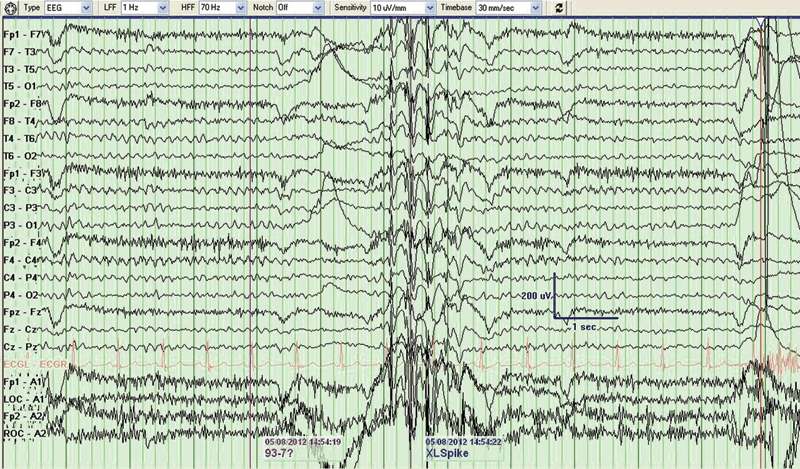
Figure 14.5. EEG with a 1-second burst of 3-Hz generalized spike-and-wave in second 6 in a patient with GTC seizures on awakening. Note: 3-Hz generalized spike-and-wave suggests a “primary” GMS, though it may be infrequently seen as a “secondary” bilateral synchronous discharge on focal origin.
The ictal EEG during a GTC seizure has generalized frontally predominant fast rhythmic spikes during the tonic phase. A 10-Hz discharge followed by a brief attenuation or low-voltage fast activity at a frequency of approximately 20 Hz is seen. Gastaut described the 10-Hz rhythm as the “epileptic recruiting rhythm,” which progressively increases in amplitude (Fig. 14.6) (19). Following the tonic phase, the frequency of the ongoing ictal activity decreases as amplitude increases in association with repetitive clonic jerks. During the clonic phase, the initial fast rhythm becomes fragmented by rhythmic slow waves. Intermittent polyspikes are apparent and accompany the clonic jerk with a decreasing slow-wave frequency during the relaxation period (5,10). The postictal phase reveals immediate suppression of the background that evolves to diffuse slowing that gradually returns to the baseline background. During the postictal phase, a nonlocalized GTC seizure may demonstrate focal or lateralizing features that suggest the event was a focal-onset seizure that rapidly evolved to a bilateral convulsion.
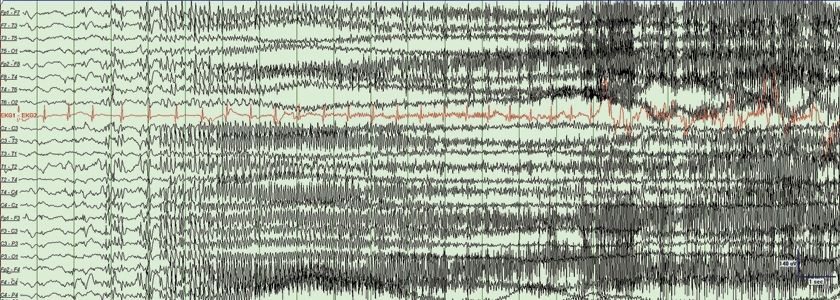
Figure 14.6. EEG during a GTC seizure in a patient with GGE. Notice the generalized onset and evolution during the seizure. (From Tatum WO. Handbook of EEG Interpretation. 2nd ed. New York: Demos Medical Publishing; 2014:135 [reprinted with permission from Demos Medical Publishing].)
Clinical Correlation
Diagnosis is usually not difficult. The aftereffects can include trauma to the head, tongue, and mouth; vertebral compression fracture; posterior shoulder dislocation; aspiration pneumonia; neurogenic pulmonary edema; and cardiac arrhythmia (5,10,20). Sudden unexplained death in epilepsy (SUDEP) may occur following a GTC due to postictal centrally mediated alteration in cardiorespiratory function (20). Some “convulsions” (i.e., benign neonatal familial convulsions) reflect terminology that is actually a misnomer since GTC seizures in infancy are more likely to be focal tonic–clonic seizures due to brain hyperexcitability with or without a genetic basis (16). GGE with sporadic GTC seizures may be self-limiting and express a single seizure semiology (5,16). Other syndromes with GTC seizures persist throughout life (epilepsy with GTC seizures on awakening). Some GGE epilepsy syndromes (JME and juvenile absence epilepsy) have mixed GMS, and some reflect combinations (epilepsy with myoclonic absences) (16,17). New-onset GTC seizures in adulthood likely have a focal onset (Video 14.1) though focal and lateralizing electroclinical signs in patients with GGE should receive consideration (11).
Many physiologic nonepileptic mimics of GTC seizures may occur. In early childhood, breath-holding spells can mimic epileptic GTC seizures. In adulthood, convulsive syncope, metabolic disturbances (electrolyte imbalance), drugs (i.e., bupropion and tramadol), and substance abuse (i.e., cocaine and alcohol) are important causes to consider. Similarly, acute symptomatic seizures within 7 days of a systemic or brain insult does not equate to posttraumatic epilepsy. However, psychogenic nonepileptic seizures exist as a leading cause in the differential diagnosis of GTC and GMS and are best addressed by video-EEG monitoring (21).
Generalized Tonic
A generalized tonic seizure (GTS) is a generalized motor seizure that is composed of generalized tonic muscular contraction with a loss of consciousness. A GTS occurs when the electroclinical onset arises simultaneously from both hemispheres (6,22,23). From infancy to adulthood, GTS may occur. Tonic seizures typically reflect the symptomatic nature of an underlying brain condition or disease process (22,23) affecting the cerebral cortex in patients with an EGE (see Chapter 20). Despite the apparent homogeneous classification of seizure semiology, various underlying pathophysiologic mechanisms occur. GTS typically occurs with varying degrees of cognitive dysfunction and mental retardation. They are the most characteristic seizure type in the Lennox–Gastaut syndrome (LGS). GTS may present as either the initial or the primary manifestation of this syndrome (22). The prevalence of GTS is inadequately represented given the discrepancy between observed clinical seizure incidence and subclinical seizures noted during polygraphic recording (23). Tonic seizures often have an unknown etiology, although congenital brain malformation, hypoxic–ischemic encephalopathy, and central nervous system infections are the symptomatic causes most often found. Mental retardation is less common when tonic seizures begin later in childhood or in adulthood and is associated with a poor prognosis for seizure control and normal development with seizure onset before the age of 2 years (22–24).
Semiology
GTS may be very brief and appear nonconvulsive. When they are brief or associated with atonic seizures, the semiology may be difficult to differentiate. Video-EEG analysis of drop attacks with the patient in the standing position demonstrates that the first manifestations of GTS occur with either tonic flexion at the hips or propulsive or retropulsive falls (24). This is in contrast to atonic seizures that begin with flexion at the waist and knees, followed by additional knee buckling leading to a fall straight downward (24,25). Taxonomy has included (i) tonic axial seizures with abrupt tonic muscular contraction and rigidity of the neck, facial, and masticatory muscles; (ii) global tonic seizures involving widespread contraction of the axial and appendicular musculature (Video 14.2); and (iii) tonic axorhizomelic seizures as an intermediate form with contraction of the upper limb muscles and deltoid muscles that leads to elevation of the shoulders. Focal seizures with asymmetrical tonic posturing are referred to as tonic postural seizures. Short tonic seizures have high-amplitude, rapid muscular contractions that involve mainly the axis of the body and trunk, maximal in the neck and shoulder girdle, and last only 500 to 800 ms with forward positioning that resembles epileptic spasms (25). When tonic posturing is observed in patients with epileptic spasms, the term tonic spasms describes this drug-resistant seizure type (26). Prolonged tonic seizures may occur with a vibratory component that resembles a GTC seizure (24,26), although GTS are much briefer, averaging 10 to 15 seconds (27).
Tonic seizures may vary from a short, upward deviation of the eyeballs with or without nystagmoid eye movements to more intense generalized symmetrical or asymmetrical tonic stiffening, loss of consciousness, falls, and repeated injury (19,28). Falls from tonic seizures may be forward or backward depending on whether the axial and lower limb musculature is fixed in flexion or (less frequently) in extension. GTS and atonic seizures are referred to as drop attacks, though GTS are associated with falls less consistently than atonic seizures because the leg muscles are often not involved or have an increased extensor tone to maintain an upright posture (23). Scars on the forehead and occipital regions may reflect injury patterns associated with propulsive or retropulsive seizures. Contraction of the respiratory and abdominal muscles may create a high-pitched cry or a period of hypopnea. Seizure intensities may vary among patients and individuals, and combined seizure types may also occur (29). The duration of tonic seizures is several seconds to a minute, although most last for 5 to 20 seconds. Tonic seizures are most frequent during stages I and II of non–rapid eye movement (NREM) sleep (22–24,30). Autonomic features may include respiratory, heart rate, or blood pressure increases; pupillary dilation; and facial flushing (22). Postictal features demonstrate a variable degree of cognitive and motor recovery, with the depth of the postictal state usually proportional to the seizure intensity (22,23). In patients with LGS, GTS may appear “subclinical” without detailed clinical testing and EEG (31). Tonic status epilepticus is not uncommon and may occur in 54% to 97% of patients with a brief initial tonic component (22).
Electrophysiology
The interictal EEG in patients with GTS is dependent on the specific epileptic syndrome and may change in adulthood (32). In most patients with GTS associated with EGE, a diffusely slow background with multifocal spikes and sharp waves (Figure 14.7b) is present on the EEG reflecting a diffuse structural injury of the brain (22). In patients with LGS beginning before the age of 5 years, generalized slow spike-and-wave complexes (Figure 14.7a) may not appear until the onset of epilepsy is well established (19,22–24,27). Epileptic spasms may have a similar semiology to GTS seizures though the EEG has the characteristic interictal pattern of hypsarrhythmia and an ictal pattern of an electrodecremental response (25,26).
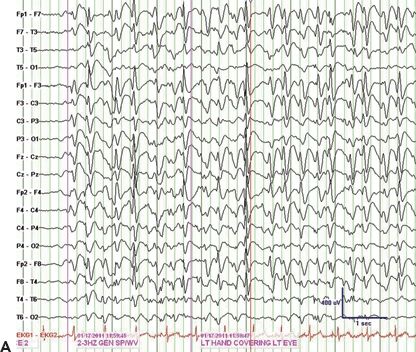
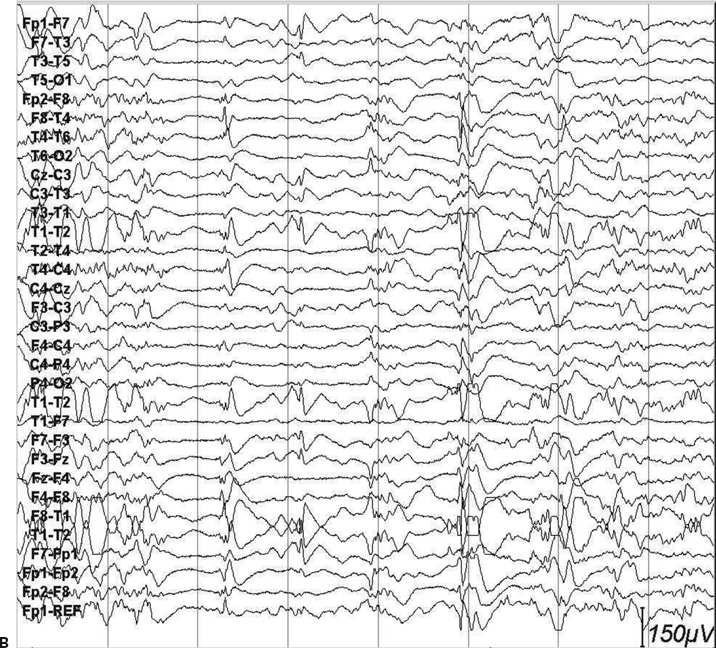
Figure 14.7. (A) Slow spike-and-waves and (B) multifocal independent spike discharges in two patients with GMS and mixed tonic, tonic–clonic, and myoclonic seizures. (From Tatum WO. Handbook of EEG Interpretation. 2nd ed. New York: Demos Medical Publishing; 2014:135 [reprinted with permission from Demos Medical Publishing].)
The ictal EEG manifestations of GTS associated with EGE are variable. Generalized paroxysmal fast activity (GPFA), generalized background attenuation, low-amplitude rhythmic fast activity of 15 to 25 Hz that progressively increases to 50 to 100 μV, and an initial attenuation followed by the rhythmic fast activity of 10 to 15 Hz that is high amplitude from the seizure onset are common features of GTS on EEG (33). Commonly, generalized frontally predominant initial attenuation of background activity that is associated with desynchronization precedes the appearance of bilateral 10 to 25 Hz spikes with voltages up to >100 μV (34). Attenuation in the EEG reflects a generalized desynchronization with or without rhythmic ictal fast activity. GPFA often appears as the electrographic counterpart of tonic seizures during slow-wave sleep and consists of diffuse, repetitive, medium- to high-amplitude spike discharges that usually have clinical semiologies with increased muscular tone (19,23). The pattern of GPFA on the EEG is a 10-Hz burst of bilateral fast activity that occurs frequently during NREM sleep, disappearing in REM sleep. Bursts of GPFA are identical to the discharges seen with GTS but may have subtle clinical signs such as brief apnea or mild muscular contraction that is best seen on electromyography (Fig. 14.8). GPFA is not pathognomonic for LGS since extratemporal focal seizures may also manifest similar bursts. A mixture of clinical and EEG patterns seen with GTS may also be associated with other types of GMS (Fig. 14.9) (23,29). Fast ictal spike discharges have been noted in the centromedian nuclei of the thalamus bilaterally with invasive electrodes that correlate with the onset of tonic seizures during concomitant scalp EEG change (35). Rhythmic and morphologically distinct ictal theta and delta have been described in patients with tonic status epilepticus and LGS (36).
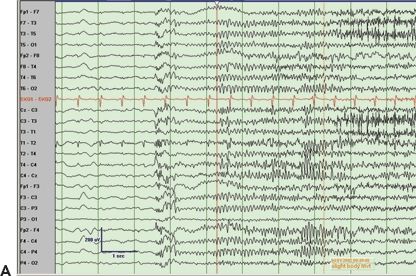
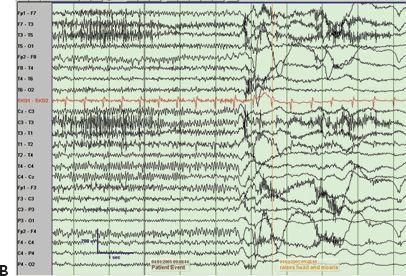
Figure 14.8. EEG of a GTS from sleep. Note the initial generalized polyspike followed by 10-Hz activity (A) accompanying a subtle GTS and the minimal myogenic artifact 3.5 seconds following onset (B) but the significant postictal slowing.
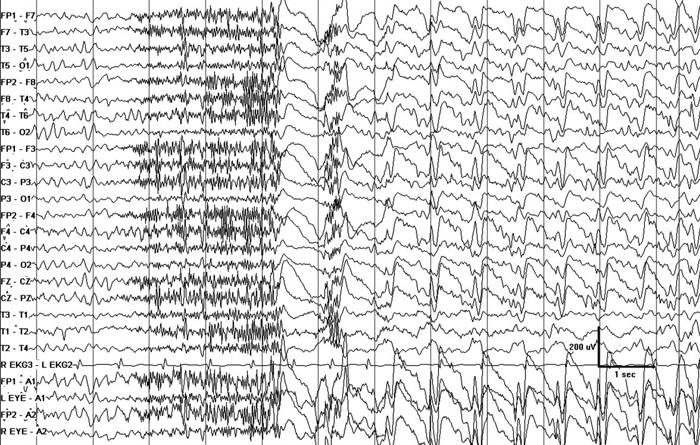
Figure 14.9. EEG demonstrating a burst of polyspikes at the onset (tonic component) that precedes a burst of generalized slow spike and waves (atonic component) during a drop attack.
Tonic postural seizures associated with localization-related epilepsy often have interictal midline spikes in the scalp EEG when they are detected (37). Ictal discharges may arise from an epileptogenic zone in the frontal cortex that is remote from the scalp EEG and be unrevealing. A regional, low-amplitude, high-frequency rhythmic ictal fast frequency discharges (33) or subtle diffuse attenuation of the background may be apparent in some patients (38).
Clinical Correlation
Tonic seizures frequently coexist with mental retardation, an abnormal EEG, and a poor response to therapy. The implication of GTS is based on the clinical history and disease course. GTS represents one of the cardinal seizure types in LGS (22,23,30). Although GTS are characteristic of LGS affecting 74% and 90% of patients (22), they may be virtually absent in other EGEs (i.e., severe myoclonic epilepsy of infancy). Tonic seizures are the most common cause of a sudden fall (drop attacks) in children with LGS (38) and a major cause of morbidity and mortality, often necessitating the use of a protective helmet (22). When seizures are present during neonatal development, GTS represent one of the earliest clinically identifiable semiologies (39). Early infantile epileptic encephalopathy is an EGE that is also characterized by frequent tonic seizures. West syndrome and epileptic spasms are a unique form of GTS, which occurs with a sudden flexion or extension followed by tonic contraction for seconds without clonic jerking. Although epileptic spasms have a semiology that is similar to GTS, spasms are more rapid in onset (lasting for 1 to 2 seconds), occur in clusters, and have hypsarrhythmia on the interictal EEG.
Seizures may appear to possess a generalized semiology even though they have a focal onset. Secondarily, GTS with asymmetrical tonic abduction and elevation of the arms may mimic tonic seizures in patients with EGE. When tonic postural seizures occur, they are often frequent, nocturnal, and associated with other focal semiologies and episodes of recurrent status epilepticus, given their predisposition to arise from the frontal cortex (40).
Nonepileptic tonic or opisthotonic posturing should also be considered when painful tonic spasms or posturing occur, even though treatment may include antiseizure drugs (ASDs). Nonepileptic tonic posturing is readily differentiated from epileptic tonic seizures by normal interictal and ictal EEG. Video-EEG monitoring has improved our identification, classification, and quantification of patients with GTS in pharmaceutical research and surgical selection.
Generalized Myoclonic Seizures (GMCSs)
A GMCS is a brief generalized motor seizure resulting in a lightning-like jerk. Myoclonus is a brief, sudden, involuntary, shock-like muscular contraction of the body that results in a movement that may be either epileptic or nonepileptic. Nonepileptic myoclonic jerks may be activated during intentional movement (action myoclonus) or occur spontaneously in the face of other neurologic conditions (i.e., spinal cord and cerebellar dysfunction). A GMCS has an electroclinical correlation with myoclonus and an ictal ED on EEG in a patient with epilepsy. A GMCS may occur predominately upon awakening or during transition to sleep. Cortical reflex myoclonus is a term that reflects a motor movement resulting from focal region of brain dysfunction in epilepsy with the clinical manifestations reflecting the area of the brain responsible for motor activation. Reticular reflex myoclonus, on the other hand, may occur with generalized epilepsy but originates in the subcortical structures and brainstem. Myoclonic seizure may occur either as part of a GGE syndrome or as a feature of EGE though rarely as a feature of localization-related epilepsy.
Semiology
GMCSs are characterized by brief, sudden, involuntary muscle contractions involving different combinations of the head, trunk, and limbs (Video 14.3). They are often generalized, but may also be limited to the face and axial musculature (41). They usually occur without detectable loss of consciousness (41). GMCS may be regular or irregular, symmetrical or asymmetrical, and synchronous or asynchronous. They may be isolated or rapidly repetitive. Myoclonic jerks may occur as a positive or negative motor movement, manifesting extra movement or a sudden loss of movement and postural tone (41). Massive epileptic myoclonus implies that a bilateral jerk is large enough to create a fall. Focal seizures with tonic posturing may occasionally mimic myoclonic seizures, though the presence of a relative asymmetry or sustained increase in motor tone should help distinguish this semiology. Seizure combination with myoclonic seizures (myoclonic–tonic, myoclonic–atonic) have been recognized by the new ILAE classification (1). GMCS may occur as part of another seizure type (i.e., epilepsy with myoclonic absence seizures). Myoclonic status epilepticus typically occurs in patients with EGE and occurs less frequently during sleep (42).
Electrophysiology
In general, myoclonic jerks have a high-amplitude, bisynchronous, diffuse spike-and-wave or polyspike-and-wave discharge as their electrophysiologic correlate despite interictal– ictal and syndromic differences (Fig. 14.10). A very brief latency between short bursts of synchronized electromyographic potentials in both agonist and antagonist muscles and that of the corresponding spikes occur. The spikes are time-locked events that are coupled with the myoclonic jerks that follow. By using back-averaging techniques, latencies are found to occur between 21 and 80 ms (43). When a myoclonic jerk is generated by subcortical structures, a generalized IED follows the first electromyographic sign of myoclonus though a primary epileptogenic mechanism has been controversial (43,44). Negative myoclonus, if due to a lapse of tone, can be seen only during antigravity posture and is coupled with either the slow-wave or the second positive component of a polyspike-and-wave discharge (41,43). Myoclonic seizures have semiologies with an electromyographic pattern, demonstrating a brief synchronous potential of <50 ms that is seen simultaneously in the involved muscle groups (41). During the myoclonic jerks, medium- to high-amplitude repetitive 16-Hz spikes are seen on the surface of the scalp EEG (44). Recordings from thalamic nuclei during myoclonic seizures demonstrate subcortical slow polyspike-and-wave discharges that lead the seizures recorded on the scalp surface in patients with LGS (35). Myoclonic jerks may appear to represent brief GTS but instead are single muscular contractions that last <200 ms, while GTS are more intense and sustained lasting for seconds in duration (22), although they may be associated with a myoclonic (or atonic) component (35). The EEG is critical in defining benign syndromes with GSW (i.e., benign myoclonic epilepsy of infancy) from more malignant epilepsies associated with GMCS and burst suppression (early myoclonic encephalopathy). Giant visual evoked potentials appearing as occipital high-amplitude polyphasic spikes may be observed during intermittent photic stimulation at low repetition rates of <3 Hz in some patients with progressive myoclonus epilepsy (45,46). Focal myoclonias are suspected to be derived from a hyperexcitable cortex responsible for motor activation. Electrographic secondary bilateral synchrony is common in patients with myoclonic jerks and extratemporal focal seizures. Generalized IEDs may show a brief delay in interhemispheric representation as a function of coherence and phase analysis (45).


Figure 14.10. Generalized polyspike-and-waves in two patients with myoclonic seizures: (A) with JME and (B) with progressive myoclonus epilepsy (adult-onset neuronal ceroid lipofuscinosis). Note the waveform similarity despite differences in the interictal (A) and ictal state (B) and clinical impact of these two syndromes.
Stay updated, free articles. Join our Telegram channel

Full access? Get Clinical Tree








